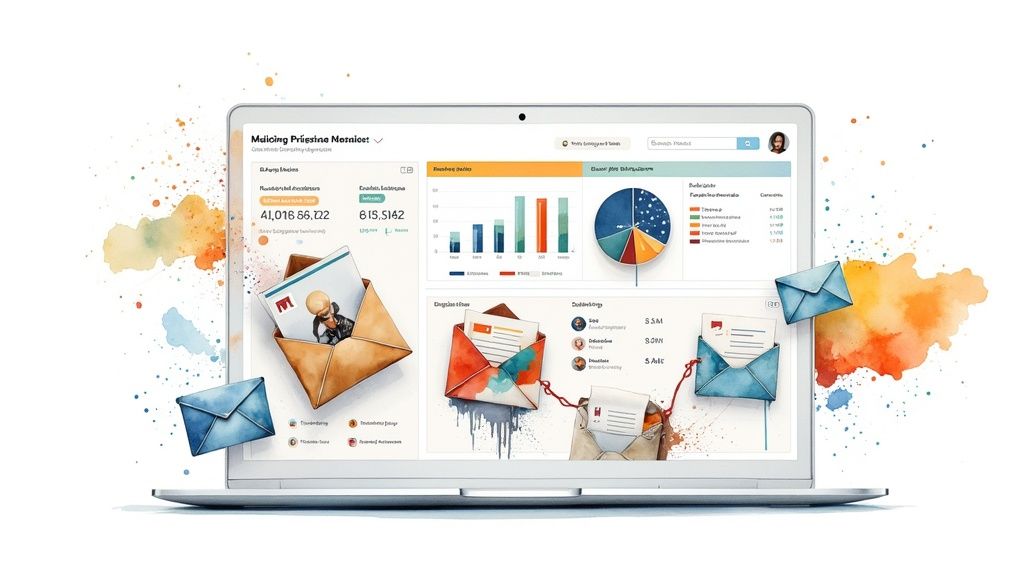In today's fast-paced business world, automation has become the key to saving time and resources. This article presents eight automated workflow examples.
In This Article
Subscribe to our newsletter
Unlocking Efficiency: The Power of Automated Workflows
Running operations smoothly and maximizing output has become essential for businesses across all industries - from publishers and media companies to e-commerce platforms. Automated workflows are a key solution that helps companies work more effectively by removing repetitive manual tasks and enabling teams to focus on higher-value work.
We've come a long way from basic scripting to today's intelligent systems that can handle complex, multi-step processes. Creating successful automated workflows requires carefully identifying bottlenecks, mapping out existing processes, and thoughtfully implementing tools to improve them. The goal isn't just speed - it's about working more intelligently while reducing errors and inconsistencies that hurt business results.
Ready to transform your operations? In this article, we'll explore 8 real-world examples of automated workflows that can boost productivity across your organization - from marketing and editorial to sales and customer support. These practical examples will show you how to make your teams more efficient and productive through smart automation.
Key benefits of automated workflows:
- Eliminate repetitive manual work
- Reduce errors and inconsistencies
- Free up time for strategic tasks
- Improve collaboration between teams
- Speed up business processes
1. Email Marketing Automation Workflow
Email marketing is still a fundamental part of driving business results, yet manual email campaign management eats up too much time. Enter email marketing automation workflows - systems that send targeted emails based on subscriber behavior and journey stage. This smart approach saves precious hours while keeping your marketing efforts running smoothly.

Think of automation as having personalized conversations with thousands of subscribers at once. Rather than blasting out generic emails, you can send messages that connect with each person - from welcome sequences for new signups to cart abandonment reminders and content recommendations matched to their interests.
Key features of email marketing automation workflows include:
- Behavior-triggered sequences: Emails sent automatically when subscribers take specific actions like signing up or browsing products
- Customer segmentation: Group subscribers with similar traits to send relevant content
- A/B testing: Try different subject lines and content to find what works best
- Performance tracking: Monitor open rates, clicks, and conversions
- CRM integration: Connect with your customer database for better personalization
Benefits:
- Better engagement: Personal, relevant emails get more opens and clicks
- Time savings: Automate routine tasks to focus on strategy
- More conversions: Well-timed messages guide customers to purchase
- Clear insights: Learn from detailed performance data
Challenges:
- Initial setup work: Need careful planning based on audience needs
- Ongoing updates needed: Keep workflows current as things change
- Deliverability matters: Follow email best practices to reach inboxes
Platform Examples:
- Mailchimp offers visual workflow building
- HubSpot connects email with full CRM capabilities
- Klaviyo specializes in ecommerce automation
Implementation Tips:
- Start simple: Begin with basic welcome emails before adding complexity
- Keep lists clean: Remove inactive subscribers regularly
- Test thoroughly: Check emails work on all devices and email clients
- Track results: Monitor key metrics to improve performance
Email marketing automation has grown thanks to platforms that make sophisticated campaigns accessible to businesses of all sizes. Want to explore more marketing tools? Check out our guide to 12 best digital marketing tools that drive real business growth.
2. Social Media Content Publishing Workflow
A social media content publishing workflow is a system that simplifies the way teams schedule, publish, and manage content across different social platforms. This process covers content planning, scheduling, tracking results, and analyzing engagement. For media companies, publishers, content creators, and marketing teams, having an organized social media workflow has become essential for connecting with audiences effectively.

This workflow stands out because it helps teams work smarter, not harder. Rather than posting manually on each platform, teams can use automation to save time and energy. Some key components include posting to multiple platforms at once, organizing content on a shared calendar, measuring results, working together as a team, and keeping brand assets organized.
Key Features & Benefits:
- Multi-platform publishing: Share content across Facebook, Twitter, Instagram, LinkedIn and other platforms - either identical posts or customized versions
- Content calendar: Map out your strategy with a team calendar to maintain consistent posting
- Analytics dashboard: Monitor key metrics like reach and engagement to improve your content
- Team collaboration tools: Work together smoothly with content review and approval processes
- Asset library management: Keep all your media files organized and on-brand in one place
Pros:
- Regular posting schedule: Keep your presence steady across platforms
- Time zone targeting: Schedule posts for optimal times in different regions
- Bulk scheduling: Plan content in advance to save time
- Combined analytics: See performance across all platforms in one view
Cons:
- API restrictions: Platform changes can affect automation features
- Less natural engagement: Too much automation may reduce authentic interactions
- Technical challenges: Scheduling issues can occur due to system problems
Real-World Examples & Case Studies:
Buffer, Hootsuite, and Later are popular tools that have shaped social media automation. Buffer focuses on simple scheduling across platforms. Hootsuite handles complex needs for bigger organizations. Later specializes in visual content for Instagram. These tools have helped many businesses expand their reach and boost engagement.
Growth & Popularity:
As social media became vital for businesses, better management tools were needed. The first scheduling tools appeared, then grew to include analytics, team features, and multi-platform management. This growth came from businesses needing smarter ways to handle their social media presence.
Tips for Implementation:
- Plan ahead: Create a content strategy and calendar to guide your posting
- Focus on themes: Pick key topics to build a clear brand voice
- Study your data: Use analytics to understand what your audience likes
- Keep some posts unscheduled: Mix automated and real-time posts to stay authentic
You might be interested in: Social Media Video Best Practices: Your Complete Guide to Driving Exceptional Engagement. This guide shows you how to create engaging videos - a key part of any social media plan.
3. Customer Support Ticket Automation
When customers reach out for help, speed and quality matter. Customer support ticket automation helps businesses deliver faster, more consistent service by handling routine tasks and routing inquiries efficiently. This lets support teams focus on what they do best - solving complex problems and delivering great customer experiences.

How It Works
When a customer sends a support request through any channel, the system automatically analyzes it and routes it to the right team member based on their skills and availability. Smart systems can even scan tickets to suggest helpful articles or draft responses for common questions. Throughout the process, built-in tracking ensures requests get handled within target response times.
Real Examples in Action
Take an online store getting hundreds of daily questions about orders and returns. Their automated system instantly sorts these requests - sending shipping updates automatically while directing complex return cases to specialists. Or consider a software company using a smart chatbot to handle basic billing questions, freeing up agents for thorough troubleshooting.
Growth and Adoption
Companies like Zendesk, Freshdesk, and ServiceNow helped establish ticket automation as a must-have tool. With 75% of customers expecting quick responses, more businesses now use these systems to meet rising service demands.
Key Features
- Smart Routing: Gets tickets to the right agent quickly
- Priority Setting: Flags urgent issues automatically
- Response Time Tracking: Monitors service level targets
- AI Assistance: Suggests relevant solutions
- Knowledge Integration: Gives agents quick access to answers
Benefits
- Up to 80% faster first response times
- More consistent service quality across all channels
- Reduced workload on support teams
- Better agent productivity through automation
Limitations
- AI may miss nuanced requests
- Setup requires initial investment
- Models need regular updates to stay accurate
Implementation Tips
- Create clear ticket routing rules
- Build a thorough knowledge base
- Review and refine workflows regularly
- Track customer feedback metrics
This tool earns its spot because it solves a universal business challenge - delivering great support efficiently. By handling routine tasks automatically, it helps teams deliver faster, more reliable service while keeping costs manageable. For growing companies especially, support automation shifts from "nice to have" to "must have" as customer bases expand.
4. HR Onboarding Workflow
A smooth, efficient onboarding process is essential for every organization. Using old-school paper forms and manual processes often frustrates new hires, creates compliance risks, and wastes valuable time. Automated HR onboarding workflows solve these challenges by digitizing and standardizing how new employees join a company - from paperwork to training to equipment setup.
What is it?
An HR Onboarding Workflow is a digital system that automates bringing new employees into an organization. It handles document collection, training assignments, equipment provisioning, and other key tasks. Rather than relying on manual processes, these systems use software to track progress, send notifications, and create a consistent experience.
Key Features and Benefits:
- Digital Documents: New hires complete and sign all forms electronically, eliminating paper forms
- Automated Scheduling: System sends reminders and schedules tasks for new hires and HR teams
- Real-Time Tracking: Dashboards show onboarding progress and highlight any delays
- System Integration: Works with existing HR platforms to eliminate duplicate data entry
- E-Signatures: Secure, legally binding digital signatures replace printing and scanning
Advantages:
- Standard Process: Every new hire gets the same organized onboarding experience
- Less Admin Work: Digital forms reduce paperwork and administrative overhead
- Better Compliance: Automated tracking helps meet regulations and internal policies
- Faster Start: New hires become productive team members more quickly
Drawbacks:
- Personal Touch: Some employees may find automated onboarding impersonal if not balanced with human interaction
- Tech Dependencies: System issues or outages can disrupt the onboarding process
- Setup Work: Initial system configuration and integration requires time and technical expertise
Example Solutions:
- Workday: Complete HR suite with robust onboarding capabilities
- BambooHR: User-friendly onboarding tools for small/medium businesses
- ServiceNow HR: Enterprise-grade onboarding automation. One financial company cut onboarding time by 40% after implementation.
Growth and Adoption:
More companies now use automated onboarding as cloud HR software becomes standard. Originally used mainly by large enterprises, these tools are now accessible to businesses of all sizes through affordable, easy-to-use platforms.
Implementation Tips:
- Create role-specific onboarding paths tailored to different positions
- Include company culture elements to help new hires feel connected
- Get input from recent hires to find areas for improvement
- Review and update workflows regularly based on feedback and needs
5. Invoice Processing Automation
Processing invoices manually is time-consuming and prone to errors. Companies can make this process much simpler by using software to handle invoices from start to finish - from receiving them to extracting data, routing for approvals, processing payments, and storing records. This approach can lead to major improvements in speed, accuracy and cash management, making it especially valuable for businesses dealing with high invoice volumes.
How Invoice Automation Works: The software uses Optical Character Recognition (OCR) and AI to pull important information from invoices, whether they're paper, PDF, or email. After validating the data, it moves through preset approval workflows. The system sends invoices to the right people based on defined rules. Once approved, it triggers payment processing and archives everything for future reference.
Key Features:
- Smart Data Extraction: OCR technology reads and captures invoice data automatically
- Digital Approvals: Routes invoices electronically through approval chains
- Payment Processing: Connects with payment systems for automated disbursement
- Complete Record-Keeping: Maintains detailed history of all invoice processing
- Vendor Portal: Central hub for managing vendor information and communications
Benefits:
- Faster Processing: Reduces invoice handling time by up to 70%
- Fewer Mistakes: Minimizes human data entry errors
- Better Cash Management: Enables capturing early payment discounts
- Full Compliance: Creates audit trails and ensures regulatory compliance
Potential Drawbacks:
- Setup Costs: Initial implementation requires significant investment
- OCR Limitations: May struggle with complex or poor quality invoices
- Technical Hurdles: Can be challenging to integrate with existing systems
Real Examples: Leading providers like SAP, Oracle, and Bill.com offer robust solutions. While specific results are often private, industry reports show most companies reduce processing times by 70% or more after implementing invoice automation.
Growth and Adoption: Cloud computing and improved OCR/AI technology have made invoice automation increasingly popular. Major software companies have helped drive adoption by showing clear cost and efficiency benefits. Stricter compliance rules have also increased demand for better audit trails.
Tips for Getting Started:
- Begin with standard, simple invoices before complex ones
- Create clear approval hierarchies and workflows
- Schedule regular system audits and checks
- Provide thorough staff training on using the system
For publishers, media companies and e-commerce businesses handling many vendor and supplier invoices, automation frees up valuable time and resources for core business activities. By reducing errors and speeding up processing, teams can improve their bottom line and operational efficiency.
6. DevOps CI/CD Pipeline
A CI/CD pipeline is an automated workflow that improves how software is built, tested, and released. CI (Continuous Integration) combines code changes into a shared repository multiple times daily, with automated testing. CD (Continuous Delivery/Deployment) automates how validated code moves to staging and production environments.
For companies that frequently update their software and services, CI/CD has become essential rather than optional. It enables teams to fix bugs and release new features in minutes instead of weeks. The efficiency gains are significant - imagine deploying critical updates almost instantly rather than waiting days.
Key features of CI/CD pipelines include:
- Automated Testing: Runs tests automatically at each stage, from checking individual components to full system validation
- Version Control: Uses systems like Git to track code changes and enable collaboration
- Deployment Automation: Scripts and tools that handle releasing code with minimal manual work
- Monitoring: Tools that track application performance after deployment
- Environment Management: Processes for maintaining consistency across development, staging and production
The growth of CI/CD aligns closely with DevOps practices. Early tools like Jenkins focused on integration, while platforms like GitHub and GitLab now offer complete CI/CD solutions.
Real-World Examples:
- Netflix: Uses CI/CD to deploy thousands of daily code changes across its streaming platform
- Amazon: Relies on CI/CD for rapid feature releases while maintaining site reliability
Pros:
- Faster Releases: Dramatically reduces time needed to deploy updates
- Better Quality: Automated testing at each stage catches issues early
- Fewer Mistakes: Automation reduces human error in deployments
- Team Collaboration: Improves coordination between development and operations
Cons:
- Setup Challenge: Building a full pipeline requires significant expertise
- Ongoing Work: Regular maintenance needed to keep pipeline running smoothly
- Resource Needs: Can require substantial computing resources at scale
Implementation Tips:
- Start Simple: Begin with basic automation and add features gradually
- Include Security: Build in security scanning to catch vulnerabilities early
- Use Infrastructure as Code: Define pipeline setup in code for consistency
- Review Regularly: Monitor and improve pipeline performance over time
While implementing CI/CD takes effort, the benefits of faster deployments, higher quality, and reduced errors make it worthwhile for most software teams. The key is starting small and building up gradually based on your needs.
7. Marketing Campaign Automation
Marketing campaign automation helps businesses manage their marketing activities more effectively by automating repetitive tasks and messaging across channels. It enables teams to deliver more targeted communications while spending less time on manual campaign management.
Strong campaign automation combines audience targeting with personalized messaging to reach the right people with relevant content. By segmenting audiences based on behaviors, demographics and past interactions, marketers can craft messages that resonate with specific groups.
For example, an online retailer might use automation to send customized emails featuring products similar to a customer's past purchases, then follow up with targeted social ads for those who clicked but didn't buy. This coordinated approach keeps messaging consistent while scaling personalization.
Major platforms like Marketo, Salesforce Pardot, and Adobe Campaign have made campaign automation accessible to businesses of all sizes. B2B companies often use Pardot for lead nurturing, while Adobe Campaign serves enterprise needs.
Key Features:
- Multi-channel delivery: Run campaigns across email, social, web, SMS and more
- Custom audience segments: Target specific customer groups
- Performance analytics: Track campaign metrics and ROI
- Content personalization: Customize messaging for each segment
- Automated scheduling: Time campaign delivery for best results
Benefits:
- Brand consistency across all marketing channels
- Better targeting with personalized messaging
- Clear ROI tracking to optimize spending
- Easy scaling of marketing campaigns
Challenges:
- Complex initial setup and configuration
- High platform costs for some solutions
- System integration can be difficult
Popular Platforms:
- Marketo
- Pardot
- Adobe Campaign
Implementation Tips:
- Set clear goals before starting automation
- Test different approaches to find what works
- Monitor key metrics like opens, clicks and conversions
- Continuously improve based on results
You might find this helpful: The Ultimate Content Repurposing Workflow: Transform Your Marketing ROI. Content repurposing works well with automated campaigns - you can automatically share blog posts on social media, turn webinars into email sequences, and create video clips from longer content. This maximizes the value of your existing materials while saving time.
8. Data Backup and Recovery Workflow
Data loss can severely damage any business that relies on digital information. Having an automated data backup and recovery workflow helps protect critical business data by scheduling regular backups, verifying data integrity, and enabling quick recovery when issues occur. This essential workflow safeguards valuable information and minimizes costly downtime.
The workflow automatically creates redundant copies of data from databases, servers, cloud applications, and workstations, storing them securely across multiple locations. Scheduled backups run without manual oversight, reducing human error risk. Automated verification processes confirm that backed-up data remains intact and recoverable.
Key Features of Data Backup and Recovery Automation:
- Regular Scheduled Backups: Automated daily/weekly backups without manual work
- Data Verification: Automated checks to confirm backup validity
- Multiple Storage Locations: On-site, off-site and cloud storage for redundancy
- Fast Recovery Tools: Automated processes to quickly restore lost data
- Security Measures: Data encryption to prevent unauthorized access
Real-World Impact:
Consider a media company hit by ransomware - without proper backups, they could permanently lose years of content. An automated backup system lets them quickly restore from secure copies, avoiding major losses. For an e-commerce business, automated backups protect customer and product databases that are essential for daily operations.
Historical Context:
Backup technology has come a long way from manual tape backups. Cloud computing enabled more advanced automated solutions. Companies like Veeam, Acronis, and Commvault helped drive widespread adoption of automated backup workflows.
Key Benefits and Limitations:
Benefits:
- Data Protection: Guards against various causes of data loss
- Quick Recovery: Minimizes business disruption after issues
- Reduced Manual Work: Frees up IT staff time
- Regulatory Compliance: Helps meet data retention requirements
Limitations:
- Storage Expenses: Backup storage costs add up for large datasets
- Network Impact: Large backups can strain network resources
- Recovery Complexity: Major recoveries may still need expert help
Implementation Best Practices:
- Test backups regularly by doing practice restores
- Document detailed recovery procedures
- Monitor backup jobs and set up failure alerts
- Create clear backup retention policies
By implementing automated data backup and recovery, businesses gain reliable protection for their essential data. This helps ensure they can quickly bounce back from data loss incidents while minimizing operational disruption.
8 Automated Workflows: Side-by-Side Comparison
| Workflow | 🔄 Complexity | ⚡ Resource Requirements | 📊 Expected Outcomes | ⭐ Key Advantages |
|---|---|---|---|---|
| Email Marketing Automation Workflow | Moderate initial setup; regular maintenance | Requires CRM integration and list management | Higher engagement and conversion rates | Personalization and actionable analytics |
| Social Media Content Publishing Workflow | Moderate scheduling with potential API limitations | Multi-platform tools and team collaboration needed | Consistent posting with unified analytics | Time zone optimization and bulk scheduling |
| Customer Support Ticket Automation | Moderate complexity with AI routing; periodic training | Integration with support systems and continuous AI training | Faster, consistent support responses | Reduced manual workload and enhanced service quality |
| HR Onboarding Workflow | Moderate setup with digital document management | HR system integration and structured task management | Streamlined onboarding and better compliance | Consistent process and reduced paperwork |
| Invoice Processing Automation | High due to OCR implementation and approval hierarchies | Significant investment and integration efforts | Reduced processing errors and faster invoice handling | Enhanced compliance and improved cash flow management |
| DevOps CI/CD Pipeline | High implementation complexity with multi-stage steps | Resource intensive with ongoing maintenance | Accelerated deployments with minimized errors | Consistent quality and improved team collaboration |
| Marketing Campaign Automation | Complex multi-channel orchestration | High tool costs and integration challenges | Scalable campaigns with improved ROI tracking | Better targeting and consistent messaging |
| Data Backup and Recovery Workflow | Moderate scheduling with detailed recovery protocols | Storage costs and potential network bandwidth requirements | Reliable data security and efficient recovery | Strong compliance support and reduced manual intervention |
Supercharging Your Business with Automation
The power of automation shines through in these eight workflow examples - they span everything from email campaigns and social posting to data backups and CI/CD pipelines. When adapted thoughtfully to your operations, these automated processes can dramatically reduce manual work, eliminate errors, and boost your team's output. The key is picking the right workflows that match your specific business needs and internal systems.
Good automation frees up your people to tackle more valuable work. Instead of repetitive tasks, they can focus on strategy, solving complex problems, and developing new ideas. But getting there takes a systematic approach.
Start by looking at which manual tasks consume the most time and create the most headaches. Those are your prime targets for automation. Once workflows are in place, keep a close eye on their performance and tweak them based on results. Remember that finding the optimal setup is an ongoing process of testing and refinement.
The automation field keeps growing with new capabilities. AI-powered tools, robotic process automation, and deeper integration between platforms are expanding what's possible. Following these developments helps ensure your automated systems stay current and effective.
Key Takeaways:
- Automation cuts manual work and errors
- Custom workflows maximize results
- Regular monitoring drives improvement
- Stay current with new automation tools
Want to transform your content creation with automation? Aeon is a specialized video platform built for publishers. It turns your text, video and audio into engaging video content with minimal hands-on work. Using AI technology, Aeon handles the full production process - from voice customization to social media formatting. You keep control of your brand and editorial standards while automating the technical work. Visit Aeon's website to see how it can enhance your video content strategy and boost audience engagement.


.jpg)